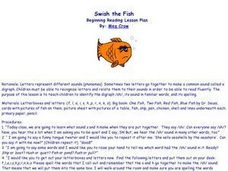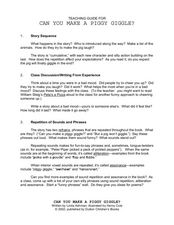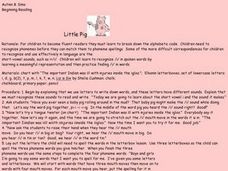Curated OER
IIII---L-lll-ke---IIII-ke-and-M-IIII-ke
Students recognize the letter combination i_e by reading and spelling words with letter boxes in this instructional activity. They say a tongue twister which emphasizes the long /i/ silent /e/ combination. They then listen the story...
Curated OER
The Fish Say Shhh
First graders identify the digraph /sh/ in written and spoken language. Students practice the production of the /sh/ sound through tongue twisters and riddles. They identify the initial and final placement of the new digraph /sh/ using a...
Curated OER
Swish the Fish
Learners study the /sh/ phoneme by making the sound, and reciting a tongue twister. Next, they make words that the teacher models using their Elkonin letterboxes. While using the big book version of Dr. Seuss', One Fish, Two Fish, Red...
Curated OER
Teaching Guide: Can You Make a Piggy Giggle?
Students explore the book Can You Make a Piggy Giggle?. In this language arts lesson, students focus on a variety of aspects within the book. Students study the illustrations, listen for rhymes, and attempt the tongue twisters in the text.
Curated OER
Camel Alliterations
Read the examples of funny tongue twisters about camels that begin with the same letter and then have students write 7 camel alliterations of their own and tell which is their favorite. Extensions: They can illustrate all of their...
Curated OER
M&M Mountain
Students practice recognizing the capital and lowercase M when practice writing with M&M's. They listen to and view the book, "Are You My Mother?," by P.D. Eastman with Random House, Inc. Each student interacts with a tongue twister...
Curated OER
Let Us Rhyme With Madeline
Listen to the book Madeline, and identify rhyming words with learners as they hear them in the book. Learners will engage in a class discussion about rhyming words. After listening to Madeline, they will circle pictures of words that...
Curated OER
Perfectly Popping
Students identify p in spoken words and the written letter the represents it. The story, Hop on Pop by Dr. Seuss is read the the class. They then have to circle pictures that have the p sound in them. This assessment is done after...
Curated OER
OOOhhhh, My Toe!!!!
Young scholars examine the /O/ phoneme by examining words and reciting a tongue twister. They practice writing the letter 'O' on their dry erase boards. While they listen to a read aloud of "Bo and Rose" they form the /O/ with their...
Curated OER
Yummy in My Tummy
Students explore phonemes in spoken words. They discuss the correspondence u=/u/. Students identify a meaningful representation for the phoneme and practice identifying /u/ in both written and spoken words. Students learn a tongue...
Curated OER
Little Pig
First graders discover that letters are used to write words and that they have different sounds. They pronounce the word, "pig" emphasizing the /i/ sound. They say a tongue twisters that features the /i/ sound in each word. They then...
Curated OER
Ugh!
First graders focus on the phoneme /u/. They make the sound and say "Ugh" and pronounce other words that contain the /u/ sound such as tub. They then repeat a tongue twister featuring the /u/ sound breaking the sound off each word and...
Curated OER
What's Up Doc?
Students demonstrate the /o/ sound by opening up their mouth and saying, "Ahhhhh". They try saying a tongue twister that contains the /o/ phoneme; repeating it two times together. They then practice writing the letter /o/ so that it can...
Curated OER
Abra-kadabra-kazam /a//a//a/, POOF!
First graders discover that each letter of the alphabet has a sound then detect the /a/ sound represented by the letter a. They pretend to be magicians and say, "Abra-kadabra-kazam! POOF!" emphasizing the /a/ sound and then repeat an /a/...
Curated OER
Don't Make that Baby Cry
Pupils study the short "a" sound in words by examining the mouth movements made when making the sound. They practice making the sound by pretending they are making baby sounds. Next, they recite a tongue twister that contains a number of...
Curated OER
Bump on the Head
Pupils discuss as a class if they have ever had a bump on the head and started crying and said /a/. They pretend they have hit their head and say the /a/ stretching it out and try a tongue twister containing the sound and write the...
Curated OER
Crying Baby
Students practice techniques and strategies with phonics, spelling and word recognition with the sounds of /a/. They read and work on this task with the book, "Cat Nap," and the tongue twister "Alice asked if Annie's active animals were...
Curated OER
Scary Scary....aaaaa!!!
Students study the /a/ in both written and spoken word by reciting a tongue twister in which they exaggerate the /a/. Next, the make given words using letterboxes after the teacher models the technique, Next, they read "Pat's Jam" to a...
Curated OER
A? Speak up, I can't hear you!
Students become phonemically aware of various sounds that make up written words. This instructional activity focuses on the vowel correspondence a_e=/A/. They decode the long a mouth moves in words as well as practice spelling the words...
Curated OER
Quirky Pink Pigs
Students study the letters 'p' and 'q' and recognize the difference between them. They practice listening for the /p/ and /kw/ sounds and engaging in activities that deal with the letters 'p' and 'q'. They also have the opportunity to...
Curated OER
The Very Hungry Caterpillar
Learners explore phonemes and short vowels. They identify /a/ (short a) sound in spoken words and learn a meaningful representation and a letter symbol for the sound. Students identify /a/ (short a) sound in words. They read "The Very...
Curated OER
The Squeaky Door
Young readers distinguish between the sounds for short vowel e and long vowel e. They are introduced to the vowel patterns that comprise long vowel sounds, with emphasis on /ea/. They practice reading and spelling a variety of words that...
Curated OER
Chuga, Chuga, Choo, Choo
Students identify the digraphs in written and spoken language. After a brief discussion on the combinations of letters that comprise digraphs, students practice identifying initial and final placement of the digraph /ch/ in words and...
Curated OER
What doe the doctor say?
Young scholars must explore the phoneme awareness. They must decode many different correspondences. Students explore the o sound by illustrating the concept using memorable tools used in by showing the o sound in spoken and written words.

























